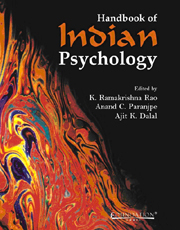Book contents
- Frontmatter
- Contents
- Contributing Authors
- Preface
- 01 Prologue: Introducing Indian Psychology
- 02 Indian Thought and Tradition: A Psychohistorical Perspective
- PART I SYSTEMS AND SCHOOLS
- PART II TOPICS AND THEMES
- 16 Indian Theories of Perception: An Inter-School Dialogue from Buddhist Perspective
- 17 Indian Psychology of Motivation
- 18 Personality in Indian Psychology
- 19 “Giving” as a Theme in the Indian Psychology of Values
- 20 The Making of a Creative Poet: Insights from Indian Aestheticians
- 21 Anchoring Cognition, Emotion and Behaviour in Desire: A Model from the Bhagavad-Gītā
- 22 Consciousness
- 23 J. Krishnamurti: Freedom from Knowledge
- PART III APPLICATIONS AND IMPLICATIONS
- Pronunciation and Transliteration of Sanskrit Alphabet
- Glossary
- Index
19 - “Giving” as a Theme in the Indian Psychology of Values
from PART II - TOPICS AND THEMES
Published online by Cambridge University Press: 26 October 2011
- Frontmatter
- Contents
- Contributing Authors
- Preface
- 01 Prologue: Introducing Indian Psychology
- 02 Indian Thought and Tradition: A Psychohistorical Perspective
- PART I SYSTEMS AND SCHOOLS
- PART II TOPICS AND THEMES
- 16 Indian Theories of Perception: An Inter-School Dialogue from Buddhist Perspective
- 17 Indian Psychology of Motivation
- 18 Personality in Indian Psychology
- 19 “Giving” as a Theme in the Indian Psychology of Values
- 20 The Making of a Creative Poet: Insights from Indian Aestheticians
- 21 Anchoring Cognition, Emotion and Behaviour in Desire: A Model from the Bhagavad-Gītā
- 22 Consciousness
- 23 J. Krishnamurti: Freedom from Knowledge
- PART III APPLICATIONS AND IMPLICATIONS
- Pronunciation and Transliteration of Sanskrit Alphabet
- Glossary
- Index
Summary
“…We usually understand charity to mean the giving of food, clothes, money and similar alms. But this is an extremely narrow sense of the term. Its true meaning is abnegation…Abnegation must not be taken to mean only abnegation of wealth. It means the abnegation of all things; even the abnegation of the self…”
(A. Ray, in the context of Bankimchandra's “Dharmatattva”)Values act as the guiding force for human behaviour. They are abstract, cognitive entities with moral-ethical or religious connotations. Essentially, values indicate what matters or things individuals consider more, or less significant with regard to specific activities or experiences (Roubiczek, 1969). Simply expressed, values show what one considers most important in life, and contain “ought” or “should”, “right-wrong”, “good-bad”, and “desirable-undesirable” components. Furthermore, values provide possibly the best explanation for why people differ so widely in their preferred pursuits in life. While some persons spend their lives working for the welfare of others, others devote their lives in the quest for the meaning of life in science, literature, the arts and religion. Yet others find it is more meaningful to spend their time and effort earning wealth and fame.
Although the study of values has been undertaken in both philosophy and contemporary psychology, there is a visible distinction in the method adopted in the two disciplines. A positivistic empirical approach is favoured by psychologists, who have underlined the belief aspect and the “desirable/undesirable” features of values (Rokeach, 1973). In addition, it has been pointed out that values reflect end-states or behaviours, are arranged in terms of importance, and are relatively invariant across situations (Schwartz, 1992).
- Type
- Chapter
- Information
- Handbook of Indian Psychology , pp. 361 - 382Publisher: Foundation BooksPrint publication year: 2008
- 9
- Cited by

